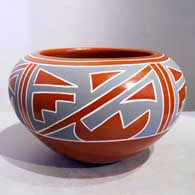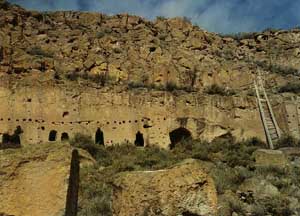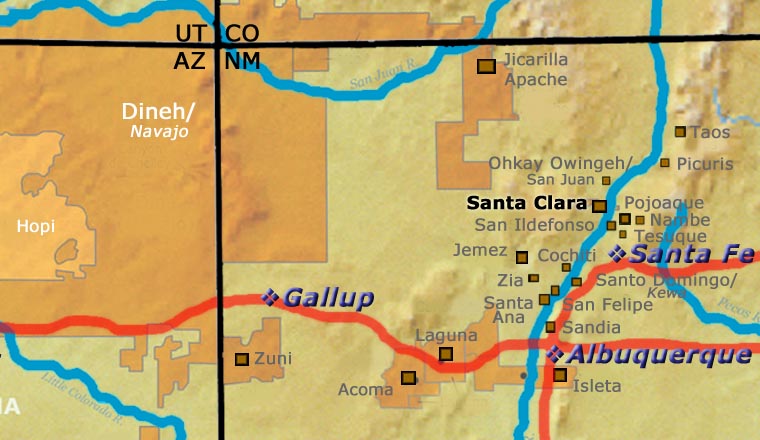
Belen Tapia
1914-1999
Santa Clara
Belen Tapia was the daughter of Thomas Tafoya and Maria Atencio but is better known as a niece of Sarafina Tafoya and cousin of Margaret Tafoya and Christina Naranjo. Belen was one of the innovators of polychrome redware. Her second husband, Ernest Tapia, traveled to hidden corners of the Pajarito Plateau and gathered the blue-grey, umber tan, salmon orange and white clays that he ground very fine to make the paints they both used to decorate her pots. She made mostly bowls, jars, wedding vases, plates and engagement baskets. Her favorite designs were kiva steps, feathers, avanyus and terraced clouds.
Belen participated in the Santa Fe Indian Market from 1979 to 1995, winning a number of ribbons including a Best of Division and a First Place in 1980. Some of her pieces were part of the Breaking the Surface: Carved Pottery Techniques and Designs exhibit at the Heard Museum in 2004. The Heard also showed other of Belen's pieces in the Recent Acquisitions from the Herman and Claire Bloom Collection exhibit in 1997.
Some Awards Won by Belen
- 1987 Gallup InterTribal Ceremonial. Class V - Pottery, Wedding Vase, First Place
- 1986 Santa Fe Indian Market. Class II - Pottery, Div. E - Traditional pottery, painted designs on burnished black or red surface, Cat. 1104 - Wedding vases, Third Place
- 1984 Santa Fe Indian Market. Class II - Pottery, Div. C - Traditional pottery, incised, Cat. 1007 - Plates, Third Place
- 1980 Santa Fe Indian Market. Class II - Pottery, Div. E - Traditional pottery, painted designs on burnished black or red surface, Best of Division, First Place
- 1979 Santa Fe Indian Market. Class II - Pottery, Div. C - Black carved plate, Second Place
- Polychrome plate, Second Place
100 West San Francisco Street, Santa Fe, New Mexico 87501
(505) 986-1234 - www.andreafisherpottery.com - All Rights Reserved

Santa Clara Pueblo

Ruins at Puye Cliffs, Santa Clara Pueblo
Santa Clara Pueblo straddles the Rio Grande about 25 miles north of Santa Fe. Of all the pueblos, Santa Clara has the largest number of potters.
The ancestral roots of the Santa Clara people have been traced to ancient pueblos in the Mesa Verde region in southwestern Colorado. When that area began to get dry between about 1100 and 1300 CE, some of the people migrated eastward, then south into the Chama River Valley where they constructed several pueblos over the years. One was Poshuouinge, built about 3 miles south of what is now Abiquiu on the edge of the Jemez foothills above the Chama River. Eventually reaching two and three stories high, and with up to 700 rooms on the ground floor, Poshuouinge was occupied from about 1375 CE to about 1475. Drought then again forced the people to move, some of them going to the area of Puye (on the eastern slopes of the Pajarito Plateau of the Jemez Mountains) and others downstream to Ohkay Owingeh (San Juan Pueblo, along the Rio Grande). Beginning around 1580 CE, drought forced the residents of the Puye area to relocate closer to the Rio Grande and they founded what we now know as Santa Clara Pueblo on the west bank of the river, with San Juan Pueblo to the north and San Ildefonso Pueblo to the south.
In 1598 the seat of Spanish government was established at Yunque, near San Juan Pueblo. The Spanish proceeded to antagonize the Puebloans so badly that that government was moved to Santa Fe in 1610, for their own safety.
Spanish colonists brought the first missionaries to Santa Clara in 1598. Among the many things they forced on the people, those missionaries forced the construction of the first mission church around 1622. However, like the other pueblos, the Santa Clarans chafed under the weight of Spanish rule. As a result, they were in the forefront of the Pueblo Revolt of 1680. One Santa Clara resident, a mixed black and Tewa man named Domingo Naranjo, was one of the rebellion's ringleaders. However, the pueblo unity that allowed them to chase the Spanish out fell apart shortly after their success, especially after Popé died.
When Don Diego de Vargas came back to the area in 1694, he found most of the Santa Clarans on top of nearby Black Mesa (with the people of San Ildefonso). A six-month siege didn't subdue them so finally, the two sides negotiated a treaty and the people returned to their pueblos. However, successive invasions and occupations by northern Europeans took their toll on all the tribes over the next 250 years. Then the swine flu pandemic in 1918 almost wiped them out.
Today, Santa Clara Pueblo is home to as many as 2,600 people and they comprise probably the largest per capita number of artists of any North American tribe (estimates of the number of potters run as high as 1-in-4 residents).
Today's pottery from Santa Clara is typically either black or red. It is usually highly polished and designs might be deeply carved or etched ("sgraffito") into the pot's surface. The water serpent, (avanyu), is a very common traditional design motif on Santa Clara pottery. Another motif comes from the legend that a bear helped the people find water during a drought. The bear paw has appeared on much of their pottery ever since.
Santa Clara has received a lot of distinction because of the evolving artistry the potters have brought to their craft. Not only did this pueblo produce excellent black and redware, several notable innovations helped move pottery from the realm of utilitarian vessels into the domain of art. Different styles of polychrome redware emerged in the 1920s-1930s. In the early 1960s experiments with stone inlay, incising and double firing began. Modern potters have also extended the tradition with unusual shapes, slips and designs, illustrating what one Santa Clara potter said: "At Santa Clara, being non-traditional is the tradition." (This refers strictly to artistic expression; the method of creating pottery remains traditional).
Santa Clara Pueblo is home to a number of famous pottery families: Tafoya, Baca, Gutierrez, Naranjo, Suazo, Chavarria, Garcia, Vigil, and Tapia - to name a few.
100 West San Francisco Street, Santa Fe, New Mexico 87501
(505) 986-1234 - www.andreafisherpottery.com - All Rights Reserved

Belen Tapia Family Tree
Disclaimer: This "family tree" is a best effort on our part to determine who the potters are in this family and arrange them in a generational order. The general information available is questionable so we have tried to show each of these diagrams to living members of each family to get their input and approval, too. This diagram is subject to change should we get better info.
- Belen Tapia & Ernest Tapia
- Leonard Tapia & Romancita Gutierrez
- Anita L. Suazo & Joseph Suazo
- Gayle Leyva & Phil Leyva
- Angel Suazo-Peter
- Leonard Suazo
- Jason "White Eagle" Suazo and Lahoma Suazo
- Cyrus Suazo
- Joseph Suazo Jr.
- Paul Tapia
- Frank Tapia & Mae Tapia
- Bennie Tapia & Gail Gutierrez
- Anna Archuleta & Fidel Archuleta
Some of the above info is drawn from Pueblo Indian Pottery, 750 Artist Biographies, by Gregory Schaaf, © 2000, Center for Indigenous Arts & Studies
Other info is derived from personal contacts with family members and through interminable searches of the Internet and cross-examination of the data found.
(505) 986-1234 - www.andreafisherpottery.com - All Rights Reserved


